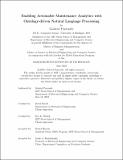Enabling Actionable Maintenance Analytics with Ontology-driven Natural Language Processing
Author(s)
Pascualy, Gabriel
DownloadThesis PDF (927.2Kb)
Advisor
Hardt, David
Welsch, Roy E.
Terms of use
Metadata
Show full item recordAbstract
Asset maintenance is a crucial aspect of biomanufacturing operations, with significant associated costs. To mitigate these expenses, companies are increasingly adopting predictive maintenance approaches that leverage data to identify potential equipment issues before they arise. Maintenance work orders (MWOs) are essential tools for planning, scheduling, and tracking maintenance tasks. Although MWOs contain explicit ontologies with structured fields for information like costs, identifiers, and dates, valuable maintenance details are often stored in unstructured text fields. These fields include work descriptions, troubleshooting information, and completed work summaries. While the unstructured text generally contains an implicit ontology, such as a shared vocabulary and references to externally documented system hierarchies, automatically extracting insights is currently infeasible, necessitating manual analysis by engineers—a process that is not cost-effective at scale.
This project aims to develop an ontology that integrates the explicit and implicit maintenance ontologies found at Amgen, as well as a natural language processing (NLP) tool for reconstructing this unified ontology from MWOs' structured and unstructured fields. By utilizing this unified ontology and NLP tool, we seek to explore the limitations of a post-processing NLP solution and pinpoint future research areas with the potential to enhance downstream analytics.
For each MWO, our tool identifies the maintained assets and their corresponding components, classifies the rationale behind the work order generation, and assigns the problem, cause, and remedy associated with each component.
Tested on a sample of 50 manually labeled MWOs covering maintenance of 188 assets, our tool achieved the following F1 scores across each category: 0.83 for failed assets, 0.46 for rationale, 0.62 for failed components, 0.58 for problems, 0.76 for causes, and 0.62 for remedies. The low F1 scores in some categories can be attributed to the missing context that is normally inferred by a reliability engineer during manual analysis. Despite these limitations, we provided recommendations for extending the explicit ontology to enhance performance and identified maintenance documentation enhancements as a potential area of future research.
Furthermore, we employed the tool to examine 1000 leak records, showcasing the significance of a unified ontology in generating accurate baselines. Overall, our findings suggest that the analytics generated by this tool could substantially reduce the time engineers spend analyzing work order data, offering unprecedented insights into plant maintenance operations.
Date issued
2023-06Department
Massachusetts Institute of Technology. Department of Electrical Engineering and Computer Science; Sloan School of ManagementPublisher
Massachusetts Institute of Technology